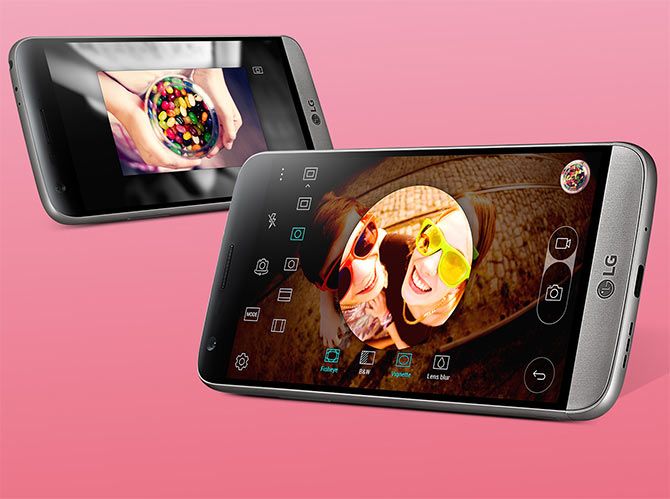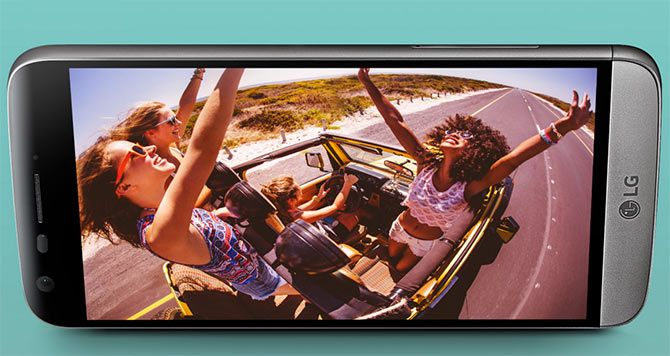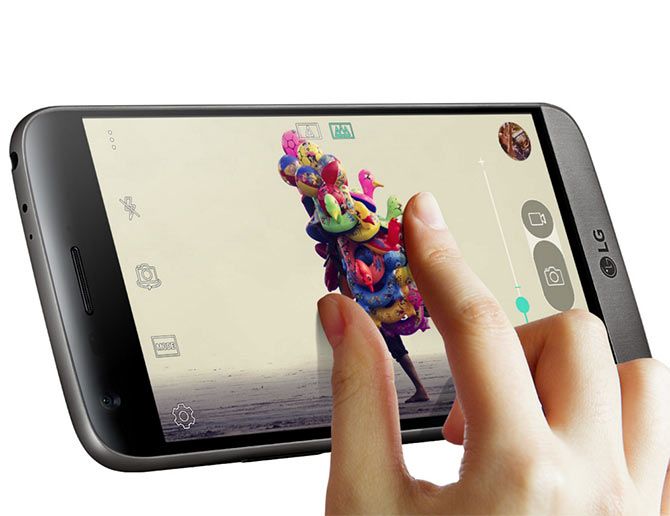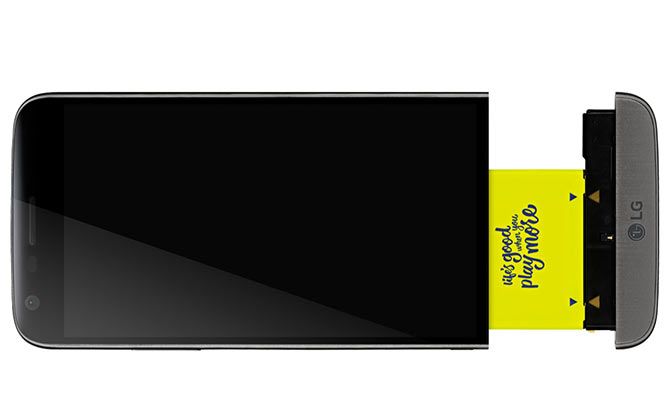The price tag of Rs 52,990 seems a bit off. Samsung Galaxy S7 has positioned itself as the flagship to beat, and with the very capable HTC 10 on the prowl, LG should have been proactive and imaginative with the pricing. A price tag of Rs 45,000 would have truly given the fillip to the first modular phone in the market, says Himanshu Juneja

LG has had quite a good run with its very own G series line up. The trend which started especially with the LG G2, the firm has been prudent enough to keep the momentum going with yearly iterations.
The year 2016 has been shaping up to be a fabulous year for the Android flagships, and LG needed a blockbuster of its own to stake their claim. The result is LG's unique LG G5, which happens to be the first modular handset available for the masses.
Apart from the lure of the unique modular concept, will a strong camera, flagship worthy display and the faithful user removable battery feature prove to be adequate enough to boost LG's chances? Let us take a detailed look at latest handset from LG.
Construction
Weighing 159 gms, and 149.4 x 73.9 x 7.7mm in dimensions, the LG G5 comes across not as very overbearing. However, its differently approached metal construction may not garner attention from all.
As per HTC, it is a die cast metal construct coated in primer, much like how motor cars are made. The paint applied has metal particles in it. But every shoe fits not every foot, and the adage may apply to some users here. But, go beyond that and the handset is a delight in every way. Maybe there is an external case for the handset which may win over the naysayers?
The handset feels solid when held, and the sharp looking chamfered edges sit nicely in contrast with the 3D Arc glass which curves nicely towards the edges. It is a great effect at play here. And even though it has a removable chin, it is not creaking or shoddy. LG could have removed the gap around the chin and it would have been even more fabulous.
Turn the phone over, and one finds the dual camera set up along with the finger print sensor at the back. Both are raised and this adds to the look and feel. The sensor is actually a home key, and it is good to see something with a tactile feedback behind the scanner. As for the buttons, the top edge plays host to the audio jack and the IR blaster, whereas the right edge carries the hybrid dual SIM slot. The volume buttons are sitting on the left edge and the bottom edge is seen carrying the USB Type C port, speaker and the microphone.
LG's modular approach meant that water proofing went out of the window, and this maybe an important factor for those who don't mind a little rendezvous with water droplets every now and then.
Display

The LG G5 carries a pretty crisp Quad HD display with a resolution of 1440 x 2560p. The decision to keep a 5.3-inch screen cranks the pixel density to 554ppi, making it pin sharp.
The IPS LCD screen is an absolute joy to work on. Unless told explicitly, one may mistake it for an AMOLED panel. Given the deep blacks, vibrant colours and the high contrast ratio, the mistake can be forgiven. LG even went a step ahead, and cleverly engineered their way to always-on display as well. Even though the feature is firmly in the AMOLED territory, LG achieved this on the LCD via a dedicated circuitry, allowing them to concentrate solely on a given section of the screen. Unfortunately, the users cannot interact with it, but with minimal battery drain, it is quite a feat.
The only disappointing area is the readability under direct sunlight. The brightness levels provided are not adequately high to negate the blinding light, but otherwise, this is pretty much a flagship display unit.
Hardware
The Qualcomm Snapdragon 820 seems to be the flavour of the year and LG chose the same for its flagship as well. With two cores chugging at 2.15GHz and another two clocked at 1.6GHz, the handset is surely not short on power.
Add the Adreno 530 for GPU, and 4 GB of RAM, the LG G5 looks quite a behemoth. There is 32 GB of ROM, with the option of further expansion via microSD card to a maximum of 200 GB. Though, the decision to go with a hybrid dual-SIM slot is something the manufacturers need to do away with.
Connectivity
The LG G5 is a 4G/LTE enabled device, and comes with the usual connectivity options like WiFi (a/b/g/n/ac), Bluetooth (ver 4.2), GPS and USB 3.0 with Type C USB connector. While the latter would mean doing away with your precious stash of regular USB cables, LG clearly took the decision with future proofing on its mind.
The USB on the go and especially the presence of Radio makes up for a further impressive specs sheet.
Software

The handset comes running on Android's Marshmallow (6.0.1), and has LG's Optimus User Interfaces slapped on top. Given the flagship status, and the competing flagships warming up towards stock android, LG too has hitched the bandwagon in a way, making the OS less plagued with their own additions.
One is greeted with the single layered OS approach, something which has been favoured massively by Chinese manufacturers. Thankfully, the option to switch over to app drawer version is present. A double tap or summoning the Knock On code lets the user go past the lock screen. Of course there is the fingerprint scanner way as well.
Once inside, the software looks neat and clean with its presentation. There is the Smart bulletin, which offers snippets from calendar events, LG health, music and IR controls, and the settings.
The option for customising the always on display is a good feature to have, revitalising the appearance every now and then.
The recently uninstalled app log is pretty useful to have, and so are the apps like battery saving, memory management, storage management etc.
The notification bar coming crashing down all the way rather than Android's signature two step pull down procedure is a bizarre 'touch up'. Thankfully, the quick toggles are customisable. There are a lot of settings options thrown around, allowing the users a handle on options like quick launch gesture for camera, keys layout, SIM card handling etc. The very useful kids mode has been included again. One also finds LG's software like Friends Manager, Backup, G5 specific apps and themes can be accessed via LG's Smart World section.
The navigation is fluid and less bloat contributes towards a likeable overall experience.
Performance
The LG G5 is not short on hardware prowess, nor is it riddled with excessive bloat. Both of these guarantee a zippy performance for the users. The handset is very quick to boot up, and there is no problem with launching, exiting or switching between of the apps. HD content runs without any stutters or dropped frame rates. Heating issues may only show up with prolonged usage, but the levels do not raise any alarms.
There is no need to wake up the phone prior to unlocking and the fingerprint scanner is quick to recognise the ridges on the fingers. That LG G5 gives Samsung S7 handset a good fight vis a vis the speedy performance, is proof enough of how capable LG's flagship is under the hood.
Camera

LG G5 comes with a dual camera set up at the rear, with 16 MP as the main shooter, while an 8 MP wide angled (135 degrees) lens being the other one. The setup comes complete with its LED flash, laser auto-focus and Optical Image Stabilisation. The front facing camera is an 8 MP variant.
The photography department is quite brilliant. The captured pics come out great even with light conditions not being perfect for the task at hand. The presence of grains is kept at a minimum, and only zooming in makes the anomalies more apparent.
Focusing was quick and OIS does its job nicely.
For pictures captured with good light conditions around, the details captured are fabulous, with colour reproduction being on the money as well, thanks to the colour spectrum sensor inherited by the handset from its predecessor.
The pop out picture is a nice add on, allowing the user to combine the captures taken from both the cameras, with the one from 16 MP unit taking centre stage. There are effects available as options too, if the user decides to go extra creative. Going a step ahead, the multi-view set up allows the user to capture pictures as well as videos from all three or two of the cameras. Pretty neat and a precious feature to have especially while being on a holiday.
The app is one of the most convenient ones around. Dedicated buttons thrown around for switching between cameras, automatic switching to wide angled lens, ditto with alternating between video and pic capture. The pro mode gives the prosumers access to manual controls, while the HDR and Panorama modes come out with great results. A bit of over-sharpening is observed here.
The front facing camera produces more than okayish results and is quite capable in itself.
The videos captured are excellent in quality, especially the ones shot at 30 fps and in 4K resolution. Same goes for the ones shot at 1080p resolution, with colours being accurate and good details thrown in.
The camera department certainly is one of the strongest suite for the LG G5. No complaints here really.
'LG Friends'
Props to LG for not only thinking out of the box, but also making the Magic Slot a robust unit in itself. The G5's chin is not short on quality, and certainly won't embarrass the user by sliding off unintentionally, or exhibit play around its contours. It slides out with a proper mechanism and stays in its place firmly.
There are exciting modules available for the handset, and LG Cam Plus is one of them. The Rs 6500 module not only adds dedicated buttons to further enhance the camera experience, it also adds another 1200 mAh battery boost. The improved grip enhances the handling. The HiFi Plus is the other module, which massively boosts the audio output. The portable Digital to Analog module is built by Bang and Olufsen, enables 32 Bit audio playback. More modules from LG should follow soon.
Apart from these, LG has revealed that there will be support for third party 'LG Friends' modules, negating any chances of a bottleneck or a monopoly by LG. It remains to be seen how other manufacturers take up the opportunity, but LG has shown enough intent for the project to take off strongly.
Battery

A sight for sore eyes, LG has again slotted in a removable battery. The power users can heave a sigh of relief here, but there is the other side of the coin as well. While the other flagships have supplied atleast 3000 mAh battery, LG chose a 2800 mAh battery instead.
The moderate to heavy users will see just about making it through a day's worth of usage, but heavier usage will definitely see a scramble for the charger. Thankfully, the support for Quick Charge 3.0 and the possibility of popping in a spare battery is a huge relief. The metal construction removes the chances of wireless charging.
One keeps getting the feeling that LG should have gone for a heavier battery pack.
Conclusion
The 'LG Friends' are definitely a big draw here, and full credit to LG for taking the bold step. If one can go past the differently approached metal construction and slightly underpowered battery pack, the LG G5 is truly a flagship worthy of a purchase.
Having said that, the price tag of Rs 52,990 seems a bit off. Samsung Galaxy S7 has positioned itself as the flagship to beat, and with the very capable HTC 10 on the prowl, LG should have been proactive and imaginative with the pricing. A price tag of Rs 45,000 would have truly given the fillip to the first modular phone in the market. The lack of battery prowess, screen struggling under direct sunlight, and a hit or a miss construction which has no water proofing, there are plenty of factors to make things wobbly.
LG has made a very unique phone here, but with the other competing flagships duking it out with very polished mainstream features, only a swift price cut can save LG from becoming a victim of its own boldness.











 © 2025
© 2025